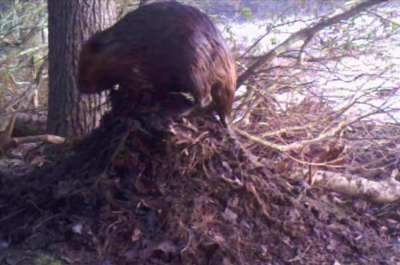Some of the most interesting animal behaviors involve social communications. Even the most solitary species need to communicate, whether they’re staking claim, communicating social standing, or advertising sexual status. We can read about the behavior and find the evidence, but there’s nothing like observing it with a trail camera. This video contains examples of scent marking by several different species.
Bobcats and Canada lynx are largely solitary animals, but they do communicate year-round with conspecifics. Scent is the preferred medium: both species spray urine on scrapes, stumps, snags, and the vertical faces of boulders, and often mark the same sites repeatedly. Once you discover a travel corridor, you can pinpoint good camera targets with your nose. In the first clip, a bobcat sprays the end of a log. Then a lynx climbs a beaver lodge and spritzes the end of a prominent stick. Watch carefully and you can actually see each cat’s spray.
Beaver lodges are appealing spots for canid marking, as well. Coyotes and foxes mark with scat and urine, often on raised surfaces. The next two video clips feature a coyote pair, and later a red fox, anointing the same lodge.
Otters sometimes mark atop beaver lodges, but more often in latrines near the dam, where they roll, groom, and scrape up mounds of debris. They leave scat, urine, and anal gland secretions on the mounds and on the ground. Latrine action is often a social event, where revelers roll, groom, and communicate with grunty chatter and chirps. If you turn the volume up, you may catch some of these sounds in my clip.
The beaver is another assiduous scent marker. It creates a mound at the water’s edge, composed of material dredged up from the pond. In spring, resident beavers mark frequently to stake claim and avoid conflict. The male, especially, will visit repeatedly to “freshen” the scent. The color video footage here shows rare daytime activity, for beavers most often tend to their mounds at night.
The beaver’s terrestrial cousins have other marking strategies. The woodchuck chews saplings near its den, where it also rubs its cheeks to deposit scent from oral glands. In the video, you can see the throw mound of the den in the background.
Gray squirrels also leave sign of chewing and rubbing, but usually on the trunks and branches of larger trees. They feed on cambium in winter, they “tap” maples in early spring for sap, and they chew and rub with cheek glands at any time of year, but particularly during the breeding season. The activity in the video occurred in the first and second weeks of January in Massachusetts. What is the squirrel doing? Is this feeding or marking? Please share your thoughts in a comment!
Janet Pesaturo is a writer, educator, and CyberTracker certified wildlife tracker. Check out her winter tracking programs and camera trapping blog here.


